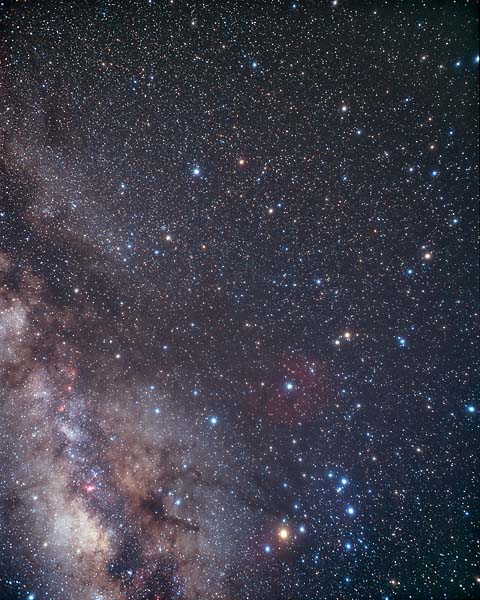DMI image reference Oph. « Previous || Next » Constellations A » H || Constellations I » V

Roll mouse over picture to see constellation outlines
Image and text ©2008 Akira Fujii/David Malin Images.
In the picture above north is at top right and the image covers about 50 x 62 degrees.
Approximate image centre is at 17:07:00, -01:43:00 (H:M:S, D:M:S, J2000)
Best seen in the early evening in July
Ophiuchus was originally Ophiuchus vel Serpentarius, the Serpent Bearer, and was represented by a male figure with a serpent wrapped around him. The name is derived from the Greek for 'man holding snake', and the figure is generally identified with Asclepius, a physician and the ship's surgeon of Argo Navis, who was later made into a God. He is often depicted as the seated figure of a man holding a stick around which is wound a snake -- the Rod of Asclepius. This distinctive symbol for physicians survives today, and was one of the first professional icons. Unfortunately the symbol widely used for this in North America shows two snakes around a rod and is known as the Cadeucius, which has a quite different connotation.
The constellation of Ophiuchus is located between Serpens Caput and Serpens Cauda, two parts of the constellation of Serpens. The southern part of Ophiuchus contains one of the darkest and most visually distinctive dark clouds of the Miky Way. It is popularly known as the Dark Horse nebula -- the body of the horse runs north-south and its legs point towards the bright star Antares. The hind quarters of the horse make up the (smoker's) Pipe nebula, with the stem pointing to Antares. The dust of forelegs reaches a long way in the direction of Antares, where it is illuminated by stars associated with Rho Ophiuchi to make a distinctive reflection nebula visible on the color images mentioned below.
The dusty clouds of the Dark Horse nebula hide the northern part of the Milky Way's central bulge. The southern part (in Sagittarius) is relatively unobscured. Without this dust the extent of the Milky Way's bulge would be much more apparent to the unaided eye and without it our understanding of the nature of our galaxy as a flattened disk might have come sooner. The large but surprisingly little-known red emission nebula around zeta (ζ) Ophiuchi is clearly visible in the image above.
Named stars in Ophiuchus (Greek alphabet)
Al Durajah (γ Oph), Cebalrai (β Oph), Han (ζ Oph), Helkath (κ Oph), Imad (θ Oph), Rasalhague (α Oph), Marfic (λ Oph), Sabik (η Oph), Sinistra (ν Oph), Yed Prior (δ Oph), Yed Posterior (ε Oph).
Constellations adjoining Ophiuchus: Aquila, Hercules, Libra, Sagittarius, Scorpius, Serpens.
Related images (other sources -- see also under 'Related Images' on the pages below)
UKS 4. Antares and the Rho Ophiuchi dark cloud